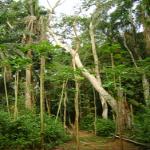April 07, 2011
In West Africa, the Guinean Rainforest is rapidly disappearing. A new study says increased production of cocoa, cassava and oil palm has meant more land is being cleared for agriculture. This could have major long-term consequences for climate change and food security.
Since the days of independence, West Africa has done a pretty good job of feeding itself. But scientist James Gockowski said that success has come at a terrible price – the loss of vast areas of rainforest.

Int'l Institute of tropical Agriculture
Guinean Rainforest
Gockowski, who's lived in the region for 30 years, has written a new report on the Guinean Rainforest for the International Institute of Tropical Agriculture and the Center for International Forestry Research.
"The forest, for all intents and purposes, is gone outside of the protected areas. And what's in its place is a mosaic of agricultural land uses and bush fallow land – land that is brought into production every four or five years on kind of a rotational basis," he said.
Gone forever
It's estimated only 15 to 20 percent of the rainforest that once stretched across coastal West Africa is still standing. And most of that is in protected areas, such as parks and forest reserves. The loss, he said, has meant biodiversity extinction.
"Mainly with species that really were unknown to science, still waiting to be discovered. These are mainly insect species and microbial species. But, as well, there are things like the forest hippo, pigmy hippo of West Africa. There are about five primate species that are on the most endangered primate species list," he said.
One primate that has become extinct is Miss Waldron's Red Colobus Monkey. It hasn't been sighted since the late 1970s and was declared extinct in 2000.
Gockowski said we'll never know how many cures for diseases have disappeared along with the forest.
Climate and environment
"This amount of deforestation can influence local hydrological cycles and influence the climate at a local level. But it is also impacting climate at the global level because several gigatons of carbon are in the atmosphere now that used to be in the rainforests of West Africa," he said.
A gigaton equals one billion tons.
Often forest land is cleared through burning. The ash that's left contains high levels of nutrients that feed crops and bring good harvests. The problem is those nutrients are depleted over time or simply washed away. The current solution is to simply burn down more forest.
"It's been an exploitation of the natural capital, the natural resources, with very little substitution of modern agricultural science in the form of fertilizers, improved varieties, improved cultural practices, etc," said Gockowski.
Using those techniques, he says, would mean greater food production on existing land, with little need for further deforestation. He says that will be necessary with a projected doubling of the population in 40 years.
"These are some serious issues that really require joint decision making between ministries of the environment, agriculture, cocoa regulatory authorities and ministries of finance or commerce," he said.
The study says cocoa production in West Africa's Guinean Rainforest doubled between 1987 and 2007. But most of that increase was gained by clearing large areas of forest.